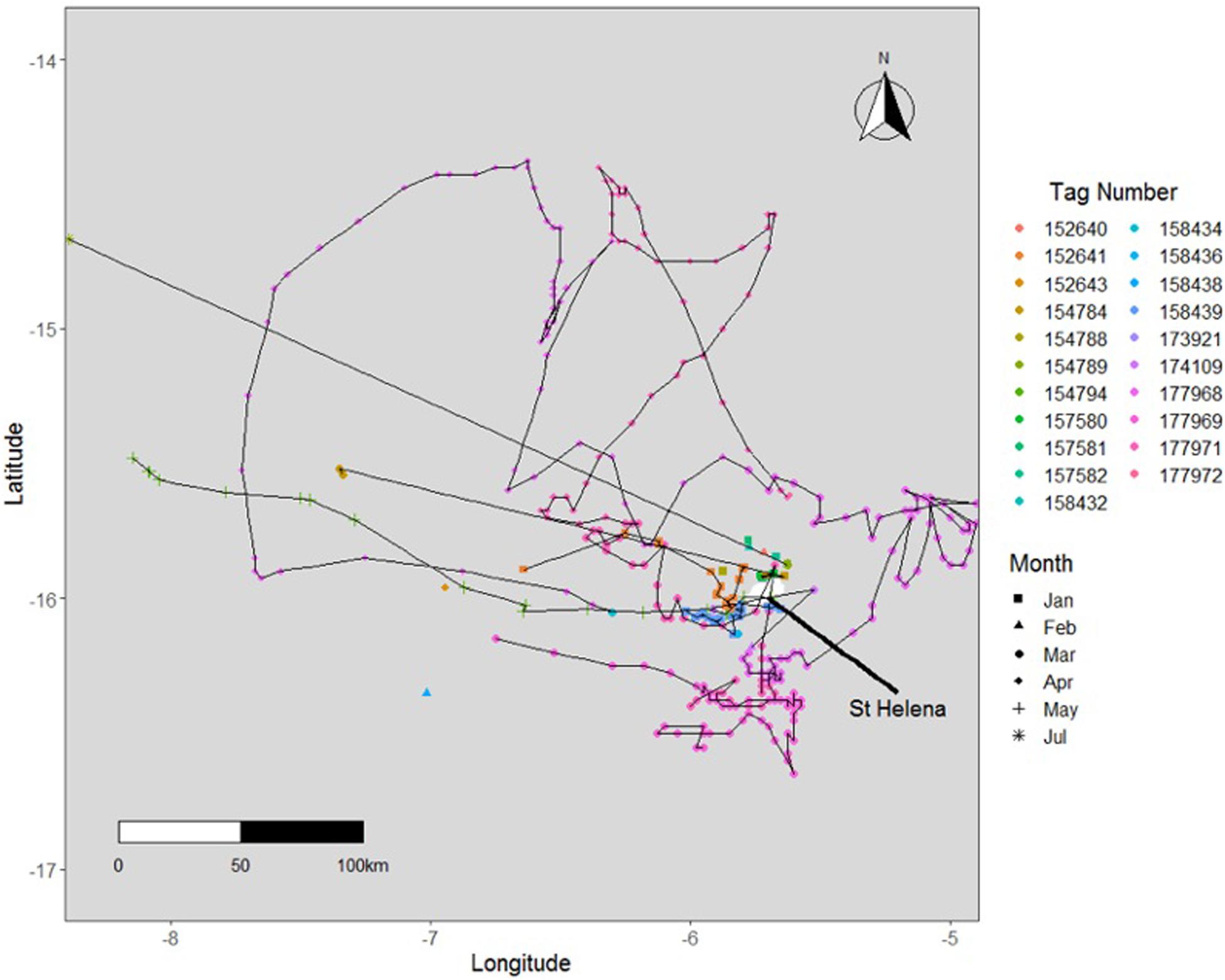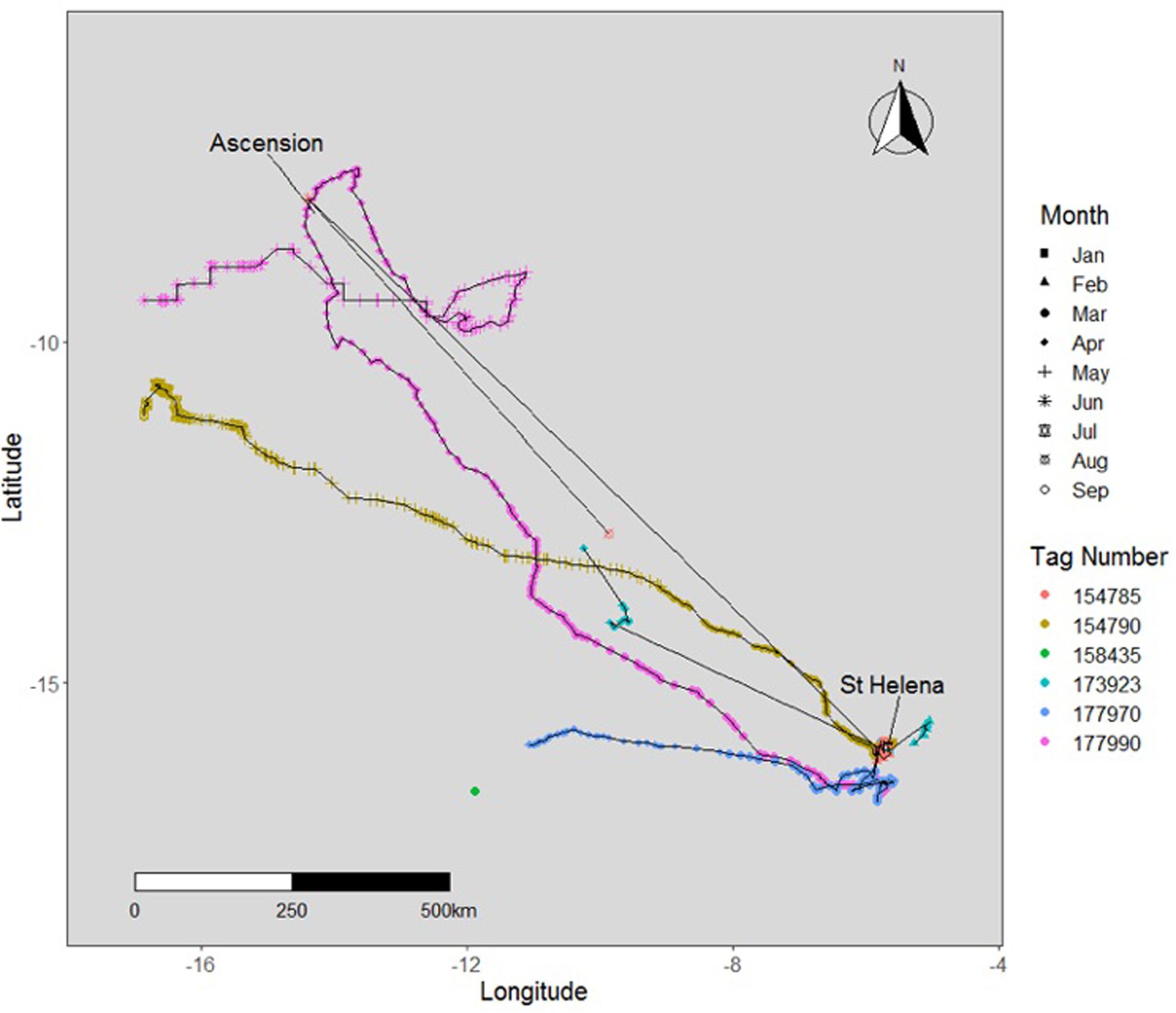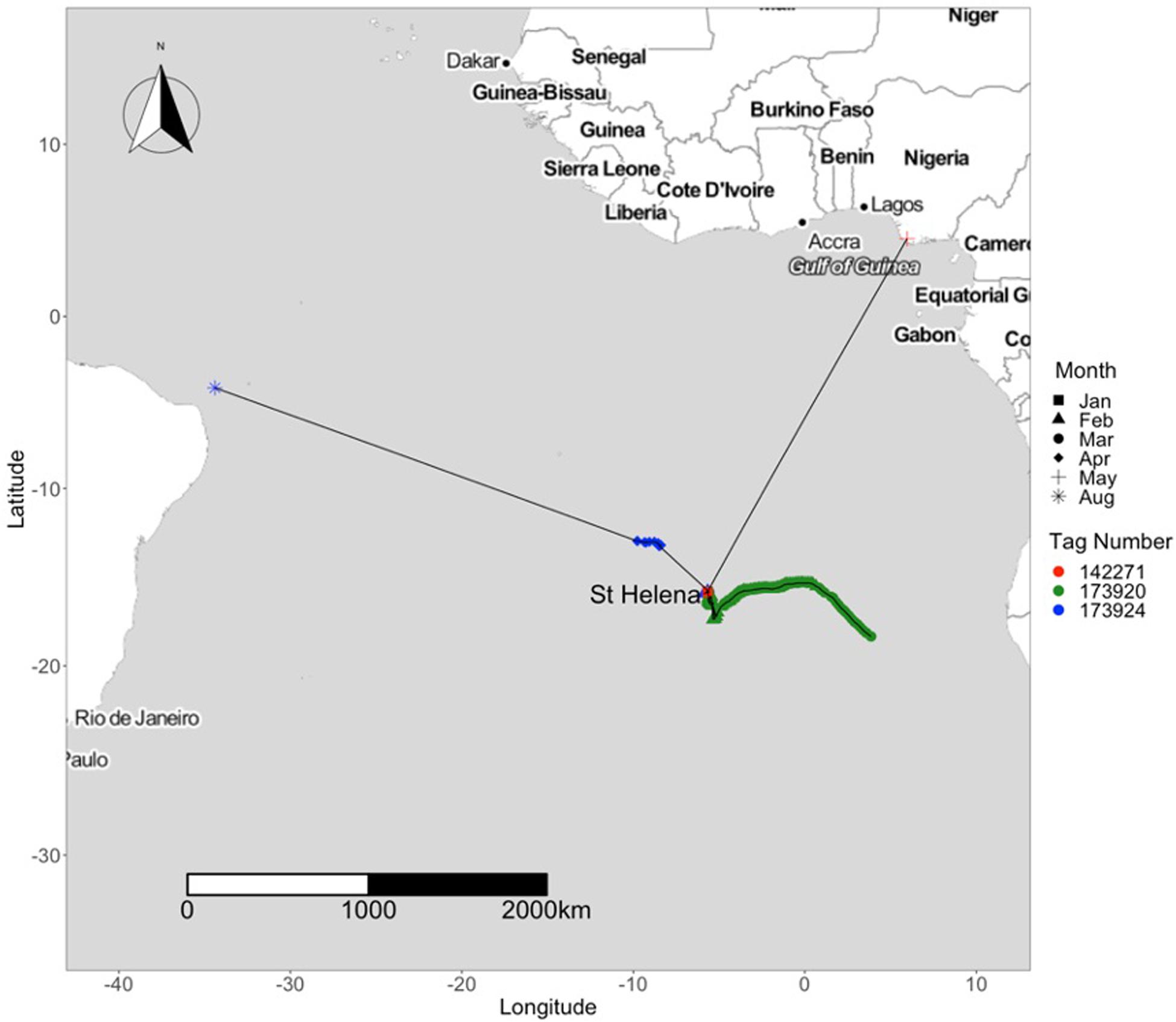← Back
Whale sharks near Saint Helena Island, Atlantic Ocean
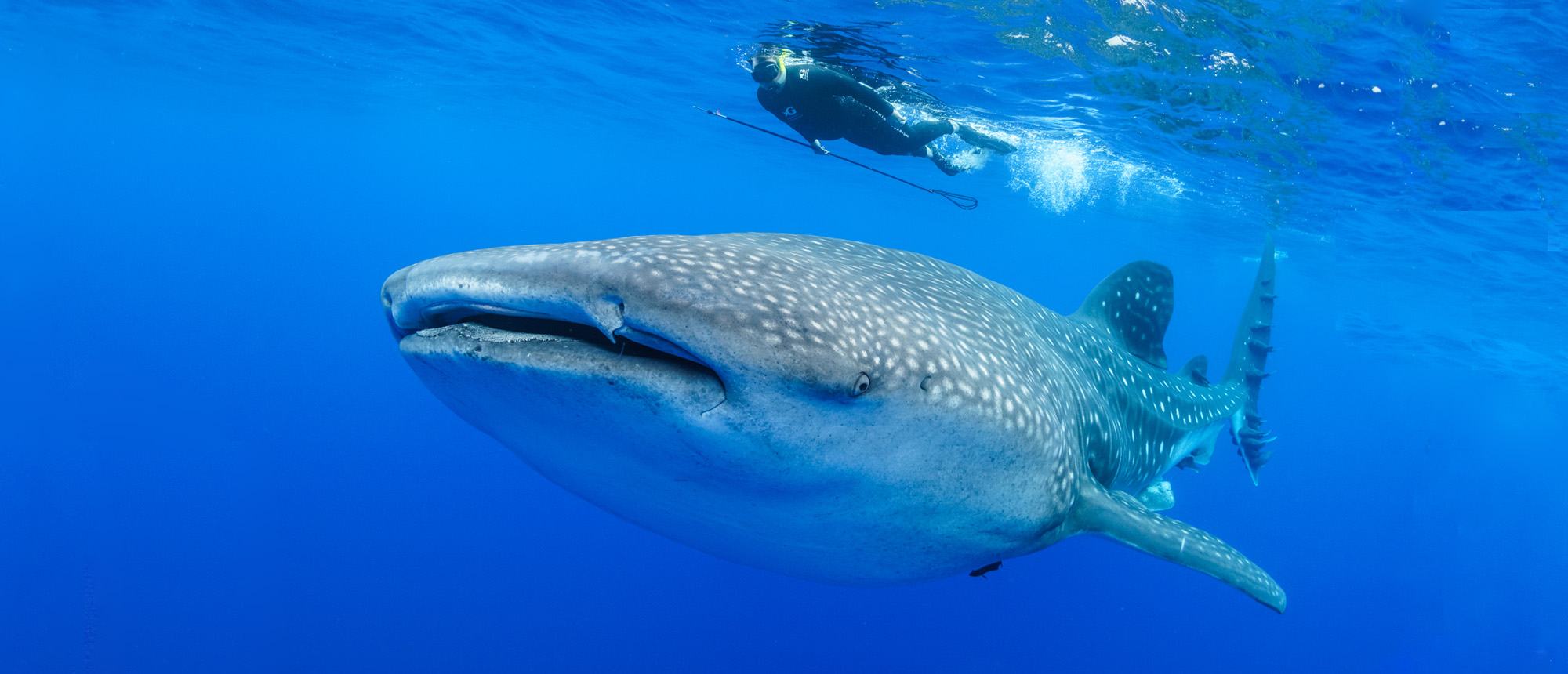
Whale sharks are found in all tropical waters around the globe, including in the Atlantic Ocean. Some places could host their reproduction, thus being critical places to protect and potentially important study sites. Argos satellite telemetry helps in trying to unveil the still remaining mysteries of this species.
Whale sharks (Rhincodon typus) are found in tropical waters all around the globe (in Indonesia, Madagascar, Galapagos…), including in the Atlantic – in the Gulf of Mexico and Caribbean, but also in the tropical South Atlantic, around the few islands located there. Some clues suggest that this precise area might be important for the whale sharks’ reproduction. The species is declining, though, and understanding their behavior and the link or lack of it between the different populations can help in recovery efforts.
Combining techniques to study whale sharks
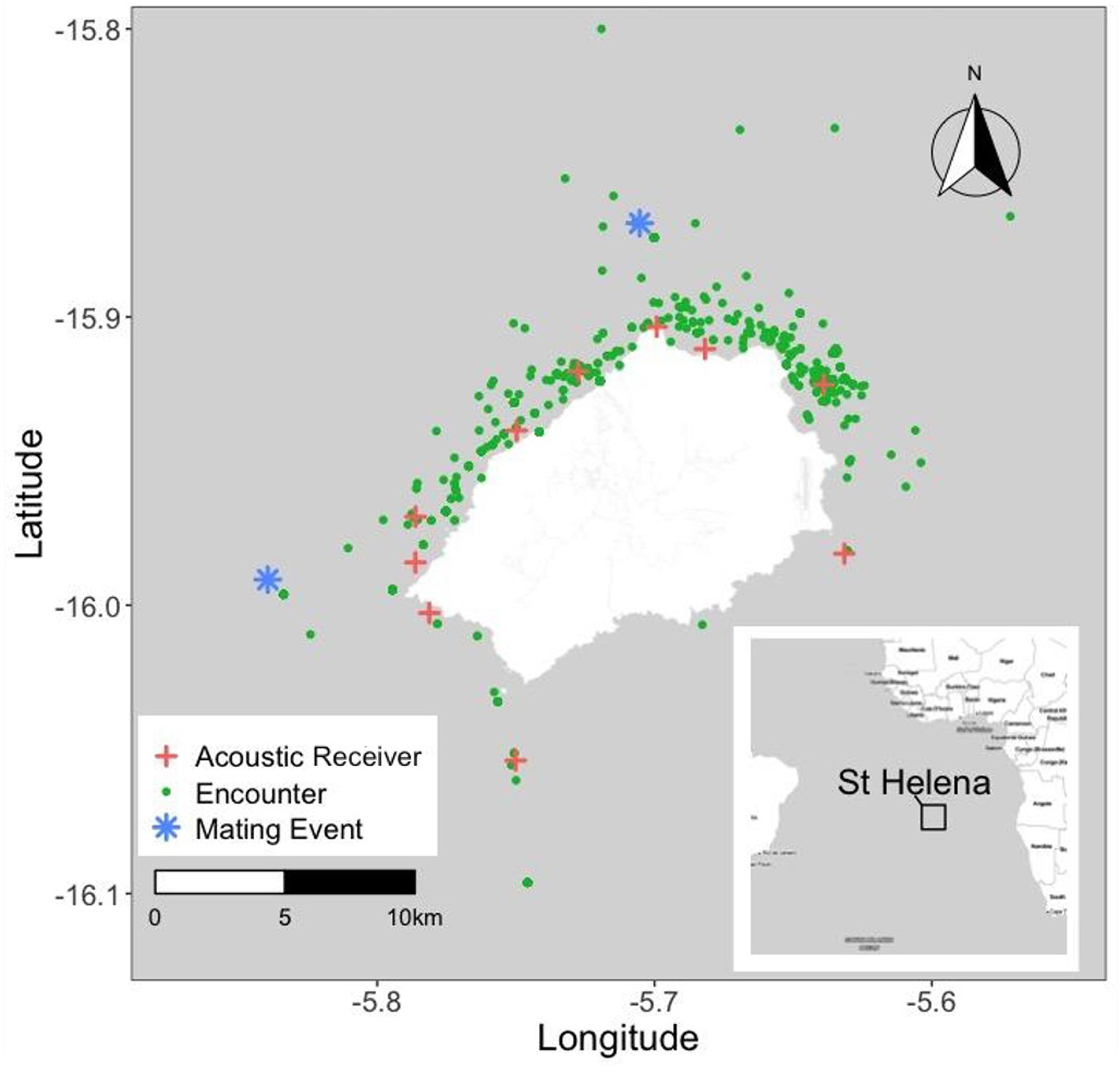
St Helena & whale shark sightings from 1999 to 2019 (green dots), sites of eyewitness accounts of mating behavior (asterisks); receivers in the acoustic array (crosses). Southeast trade winds create a difference in navigability between the calmer leeward side facing the northwest, and the rougher windward side facing southeast. (Credit Georgia Aquarium and Georgia Institute of Technology)
The island of Saint Helena in the South Atlantic is one of the most remote inhabited islands on the world. A population of whale sharks is found also there, from December to May each year.
A collaborative study of this population was led by scientists from Georgia Aquarium and Georgia Institute of Technology, with their main partners in the St Helena Government, using sightings reports and identification from natural body marking photos, acoustic and also satellite telemetry. Photographic identification enabled the team to better assess the population demographics of St. Helena whale sharks, while satellite and acoustic telemetry were combined to explore both their large and fine-scale movements.
Models suggested that about one hundred sharks were at the island at any given time during the season, staying an average of 19 days in the area, mostly adult males and females in equal ratio. This is highly unusual, since most known whale shark aggregations are mostly composed of juvenile male individuals. Eyewitness accounts of mating behavior have been reported by reliable local observers on two separate occasions, and also other reproductive behaviors. Mating behaviour has not been observed anywhere else in the world. This and the male/female adult ratio tend to reinforce the hypothesis of an important reproductive site.
More info about animal tracking with Argos
Satellite telemetry analysis
Fifty satellite Argos PTTs were fitted on whale sharks, either position-only tags to evaluate horizontal movements or pop-up archival tags for vertical movements. Thirty reported reliable data. Some detached at predefined depth of 1,650 or 1,850 m to avoid being crushed by the pressure (the waters around St Helena are deeper than the actual pressure tolerance of the tags); others might have been damaged for the same reason.
This, and the fact that the sharks must travel more than 1,000 km to reach the closest island (Ascension), and more than 2,000 km for any other habitat, led to no new clues of the connectivity between the different Atlantic populations. However, six individuals went to Ascension Island, and three reached either Africa or South America. Among the majority having stayed around St Helena, the individuals were located all around the island, contrary to the locals’ perception of a concentration on North/East.
Archival pop-up tags were fitted on whale sharks. Eight reported diving data with 509 daily dives. Around the island, all tagged animals dove almost every day, at day, to a maximum depth of around 600 m. After leaving it, though, diving pattern abruptly changed for less regular one with many very deep dives in the bathypelagic zone — deep enough to trigger the tag release/destruction. This subjects the animal to changes in temperature from 25°C to 3°C, and in pressure of nearly 200 atmospheres! The reason of this behavior is still to be understood. It might be linked to long-range travel, but more data are needed.
Protecting breeding grounds
The likelihood that St Helena is an important Atlantic breeding ground for such an endangered species as whale shark suggests that more studies should be conducted around the island, to confirm this hypothesis (Galapagos might be the equivalent in the Pacific, see News alert: Argos data provides shocking evidence to legitimize Marine Protected Areas). The aggregation of a large number of whale sharks around the islands, their deep-diving behavior when leaving, should lead to more research and conservation efforts in that area.
The data were used in support of an IUCN Class VI Marine Protected Area designation for the island’s entire Exclusive Economic Zone, and a best practice code of conduct for the growing whale shark tourism industry has been put in place with the help of the research team. St Helena is out in front of conservation issues with respect to whale sharks.
Reference & links
- Perry CT, Clingham E, Webb DH, de la Parra R, Pierce SJ, Beard A, Henry L, Taylor B, Andrews K, Hobbs R, Araujo G and Dove ADM (2020) Helena: An Important Reproductive Habitat for Whale Sharks (Rhincodon typus) in the Central South Atlantic. Front. Mar. Sci. 7:576343. doi: 10.3389/fmars.2020.576343
- http://www.whaleshark.org/
Photo: Dr. Alistair Dove from Georgia Aquarium tagging an adult whale shark in waters surrounding St Helena island in 2019. (© Simon Pierce, https://www.simonjpierce.com.)

